RV Surge and Spike Protection
Properly Protecting Your RV's Electrical System
Article Date: May, 2011
Article and Photography by Mark Quasius
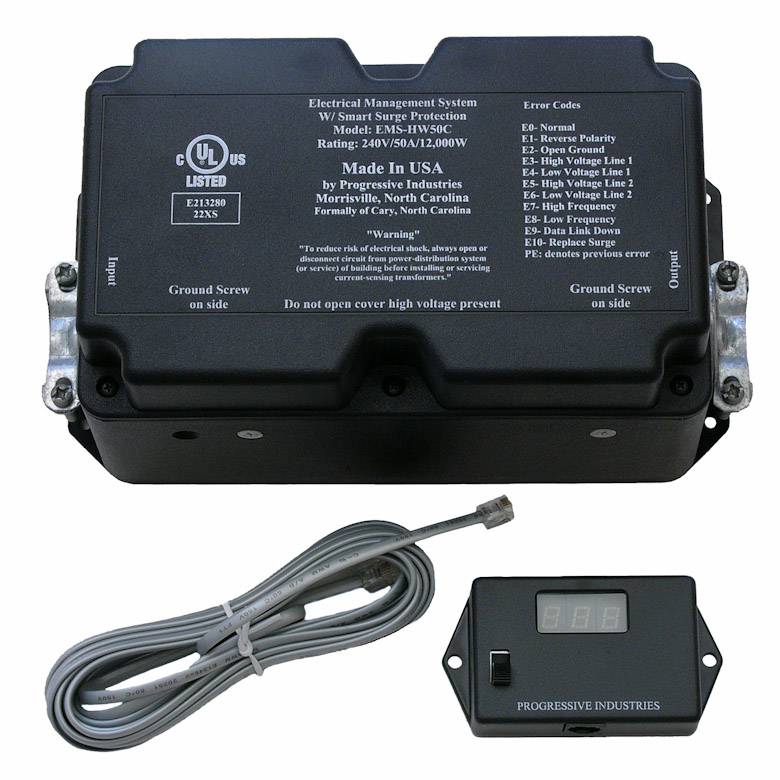
An RV is loaded with electrical components. To keep your air conditioners, battery chargers, and entertainment systems
operating in perfect order, clean electrical power needs to be supplied to the RV. Yet, campgrounds are not always the best at providing
surge-free protection.
Surges, spikes, low voltage, and incorrectly wired pedestals can cause serious (expensive) damage to your RV's
electrical system. Fortunately, a number of aftermarket devices are available to combat the dreaded surge and spike.
What They Do
|
Generally, these devices are referred to as surge protectors. However, surge protection is only a small part
of protecting your RV. Spikes and low voltage as well as surges are harmful to your RV. An electrical surge is when incoming voltage
rises higher than what it should be. A spike is similar to a surge except that it lasts for one or two nanoseconds, whereas a surge
lasts longer. A good analogy is water pressure. If your water pressure is excessively high, you'll have blown lines in your plumbing
system.
A surge protector will prevent these spikes and surges from passing through the system. It does this by utilizing
metal oxide varistors, commonly knows as MOVs. A MOV does nothing at normal voltage levels, but when the voltage rises to an unsafe level,
it shorts that power to ground. Energy surges are rated in units of joule. Try to find the highest rating possible when shopping for a
surge protector.
|
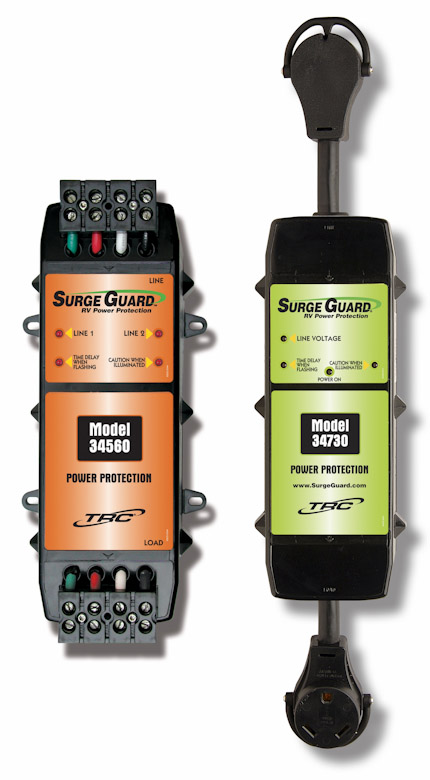
This 50-amp hardwired Surge Guard will still function when using a dogbone adaptor on a 30-amp pedestal. In addition to the
hardwired model, portable units, such as this Surge Guard 30-amp unit, can be found hanging on campground pedestals.
|
Most products referred to as surge protectors also contain some sort of low- and high-voltage protection. This is
important because many RV electrical problems stem from low-voltage power from a campground pedestal. When the voltage drops, the amperage
increases and this creates extra heat, which causes items such as motors and electronics to fail. A good surge protector will disconnect
power to the RV whenever the incoming voltage falls out of the acceptable operating parameters, typically 106 volts on the low side and
132 volts on the high side.
|
A good surge protector will also test the incoming power to make sure that your pedestal is wired correctly.
If a 120-volt outlet is wired for 240 volts, you have reverse polarity, or you have an open neutral, the surge protector will not
allow power to pass through. It should also have some sort of display or a series of LEDs that will inform you if your incoming
power is correctly wired.
|
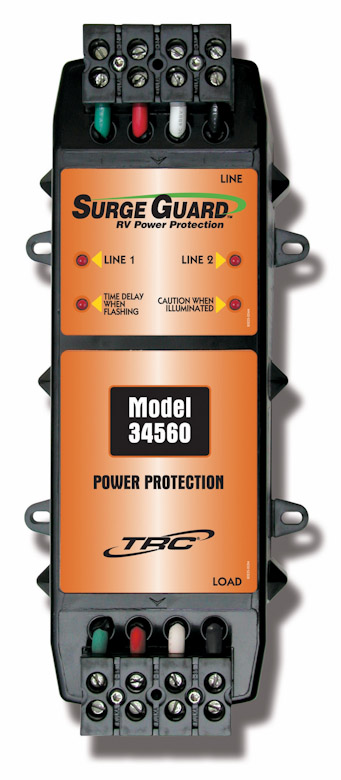
Progressive Industries makes the very popular EMS HW50C unit. This unit features an easy to read LED remove display showing incoming
voltage, amperage draws, and frequency, as well as any error codes. The display module can be mounted inside the RV
if desired.
|
AC places a heavy load on an RV's electrical system. Electrical motors in general require three times the current
to start them as it does to run them. AC compressors have high head pressures on startup that create additional demands that can trip a
circuit breaker. Modern units have a built-in delay that will not allow you to start an air conditioner until a certain time has passed
since it was shut down, so that the head pressure can bleed off to lower the starting amperage. Fortunately, should you have older units,
most surge protectors can be set to add a 2-minute delay so that your ACs can bleed down after a power failure restart.
Shutting Down the Power
If your surge protector shuts down power to the RV due to low voltage, you have options.
You can wait it out to see if the voltage comes back up to a useable level. Generally, campgrounds with low
voltage have added sites beyond what the electrical service was originally designed for. Later in the afternoon when other campers
switch on their AC, the load on the grid can be too much, so the voltage drops to an unsafe level. Those campers without surge
protectors run the risk of causing serious damage to their AC compressor motors, capacitors, and other electric components.
If you don't want to wait it out, you can run your generator to provide clean power. If running your generator
is not an option, most surge protectors do offer a bypass mode that will allow you to supply power to the RV during low-voltage
conditions. Be aware that you should only do this when power is absolutely needed. In that situation, switching off your AC and
entertainment system is advised. Use this mode only to power your basic electrical needs.
Voltage Boosters
Another option is to use a voltage booster. A voltage booster, such as the popular Hughes Autoformer or
Surge Guard's Voltage Regulator, will boost the incoming voltage by 5, 10, or 15 percent. If your low voltage drop isn't that
serious, the Autoformer will boost the incoming voltage so that you can continue to operate your electrical accessories safely.
They are normally sold as portable units, but an optional hardwire kit is generally available to install in your RV. This kit
consists of a socket and whipcord to insert into your RV's electrical system, so that the Autoformer can be removed or inserted as needed.
|
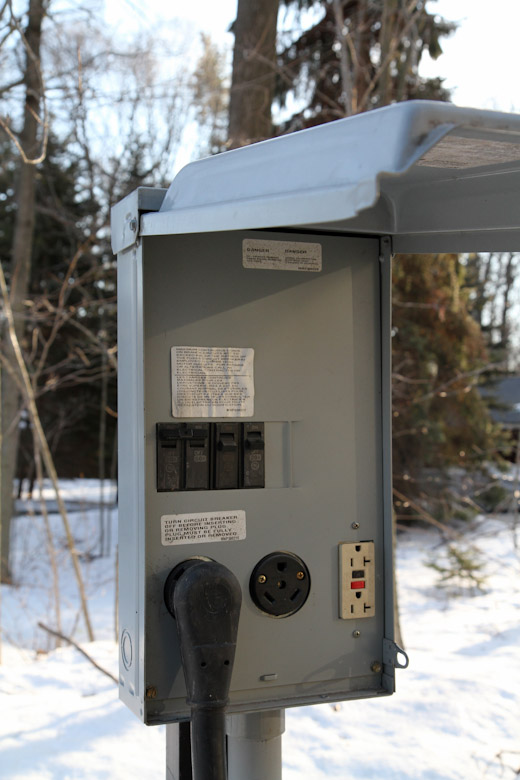
Surge protectors will shut down power from your pedestal if the incoming voltage is not within a safe range.
|
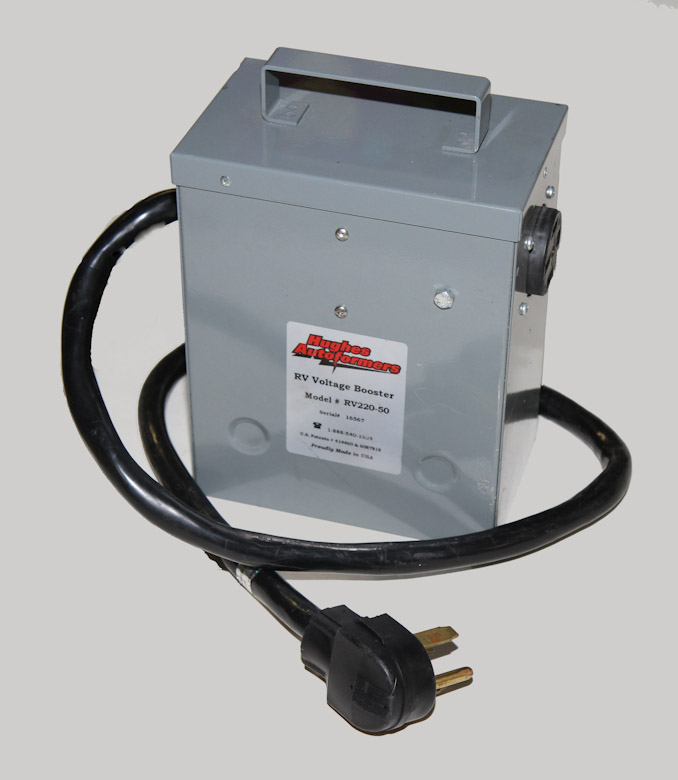
Surge Guard has recently introduced its own voltage booster. Designed to be portable, the 10175 Voltage Regulator
is also offered with optional wall-mounting bracket for RV owners who would rather place the unit in a basement
compartment.
|
Types of Protectors
Surge protectors can be hardwired into your RV or they can be portable. For portable units, you plug your power
cord into the surge protector, which connects to the campground pedestal. However, your surge protector is now out in the open and
subject to rain as well as theft. It's also one more thing to have to connect when you set up camp.
Hardwired units are mounted inside the RV and are wired directly into the electrical system. They should be
connected between the power cord and the transfer switch. Some owners simply cut a few feet off of the cord and splice the unit in,
while others just add a short whip between the surge protector and transfer switch. Hardwired units are theft proof and are not exposed
to the elements, so they are a better choice. However, smaller RVs with limited compartment space and no transfer switch may be best
served with a portable unit.
Surge Guard and Progressive Industries make the most popular and widely accepted surge protectors. Various models
are available in 30-amp and 50-amp versions, as well as both portable and hardwired. Some models offer remote displays.
The choice for our motorhome was the Progressive EMS HW50C with remote display. The remote display shows incoming
voltage, as well as frequency and amperage draws. It uses a bright red LED rather than a dim LCD, so it's easy to read in bright lighting.
We chose to mount it in a power-cord compartment where it could be easily seen, while the surge protector is mounted
in the rear of the compartment. We chose this location so that it could be viewed when we first plug the RV into the pedestal. But most
RV owners mount the display inside the coach. We preferred the Progressive unit, because the majority of the Surge Guard units do not
indicate if the MOVs have blown and will continue to pass current even after the surge protection capability has failed. The Progressive
will display an error message when appropriate and is also field serviceable, so we can replace any blown MOVs or components without
having to send the unit in.
Every RVer should consider some sort of surge protection. With the value of the electrical components in your RV
and the potential for some expensive damage from electrical anomalies, RVing without surge protection is similar to driving without
insurance. Fortunately, the wide variety of offerings in this area provides some great solutions to this common problem.
Source
Surge Guard
(800) 780-4324
www.trci.net/products/surge-guard
Progressive Industries
(256) 249-4965
www.progressiveindustries.com
Hughes Autoformers
(888) 540-1504
www.autoformersdirect.com
Return to Home Page
If you enjoyed this article be sure to recommend RVtechMag.com to your friends, like us on Facebook or Twitter
or subscribe to our RSS feed.



|









